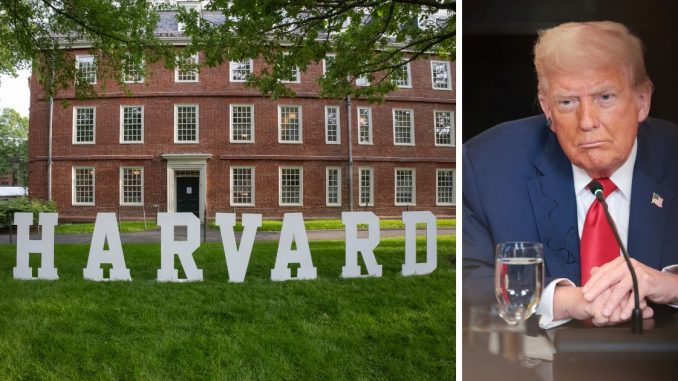
(L) A Harvard sign is seen at the Harvard University campus in Boston, Massachusetts, on May 27, 2025. (R) U.S. President Donald Trump listens as African Leaders deliver remarks during a multilateral lunch in the State Dining Room of the White House July 9, 2025 in Washington, DC. (Rick Friedman – AFP / Getty Images ; Win McNamee / Getty Images)
Published July 12, 2025
 Harvard Eyes $1 Billion Conservative Pivot Amid Trump Pressure and Free Speech Storm
Harvard Eyes $1 Billion Conservative Pivot Amid Trump Pressure and Free Speech Storm
In a stunning move that could reshape the ideological balance of American academia, Harvard University is reportedly considering a $1 billion initiative to establish a center for conservative scholarship. Once considered the stronghold of progressive thought, the Ivy League institution now finds itself at the crossroads of political pressure, campus unrest, and an intensifying federal crackdown. With former President Donald Trump demanding sweeping reforms and threatening to strip Harvard of federal funding, the university’s potential pivot raises a powerful question: Is this a genuine embrace of intellectual diversity—or a high-stakes strategy for institutional survival?
🧭 Harvard’s Proposed Conservative Center
-
What’s being considered? Harvard is reportedly exploring the creation of a “center for conservative scholarship” or institute—likely modeled after Stanford’s Hoover Institution. The estimated cost ranges from US $500 million to $1 billion.
-
Purpose: To promote viewpoint diversity, ensuring conservative and classically liberal ideas get institutional support. Advocates frame it as nonpartisan, emphasizing rigorous, evidence-based debate.
-
Catalysts: Triggered by:
-
Accusations of liberal bias and antisemitism following pro‑Palestinian protests in late 2023.
-
Intense pressure from the Trump administration, which has threatened to pull billions in federal funding, revoke accreditation, tax-exempt status, and restrict international student enrollment.
-
🎯 What’s at Stake
-
Trump admin’s stance: They view the center as possibly a symbolic gesture—insufficient to address broader demands on admissions, faculty hiring, governance reform, and protections against antisemitism.
-
Harvard’s strategy: The school aims to preserve institutional autonomy while showcasing initiative on viewpoint diversity—negotiations are ongoing, with senior officials like President Alan Garber involved.
-
Legal backdrop: Education and HHS departments have formally warned that Harvard may risk its accreditation and eligibility for federal grants due to alleged failures to protect Jewish students under civil rights laws.
-
Funding showdown: The administration has already frozen over $2.2 billion in research grants, and is assessing up to $3.3 billion in aid. Harvard has filed litigation to challenge these actions, with a court hearing set for August.
🧩 Broader Context & Implications
-
Part of a national movement: The proposed center follows a pattern where universities—especially in conservative states—create institutes to balance liberal dominance (e.g., Arizona State, UNC, UF, Yale).
-
Campus climate: A 2024 survey showed only one-third of Harvard seniors felt comfortable discussing controversial topics. Meanwhile, just 3% of faculty self-identified as conservative.
-
Institutional risk: Under mounting pressure, Harvard is also:
-
Hiring Trump-connected lobbyists.
-
Imposing hiring freezes and curtailing graduate admissions as part of a broader defensive posture.
-
📌 Resulting Effects: What This Shift Could Mean for Harvard and Beyond
🔄 Campus Culture Recalibration
Harvard’s proposed conservative institute could inject a long-missing ideological balance into campus discourse. With over 90% of faculty identifying as liberal and only a small fraction of students reporting comfort with expressing non-progressive views, this move could:
-
Encourage more open debate on controversial issues.
-
Attract diverse thinkers and faculty who previously avoided elite academia.
-
Challenge the “groupthink” often criticized by free speech advocates.
🧑🎓 Academic Realignment
The new center could:
-
Offer fellowships, faculty chairs, and courses rooted in classical liberalism, traditional values, and constitutional thought.
-
Serve as a magnet for conservative scholars, offering them legitimacy and protection in an environment that many say has grown increasingly hostile.
-
Influence curriculum design and shift research priorities toward themes like national identity, Western civilization, and free-market economics.
💸 Federal Funding & Political Leverage
Trump’s administration has already frozen over $2 billion in federal funding, threatening further cuts unless Harvard shows measurable change. This new initiative:
-
Might appease federal critics, potentially unfreezing grants and halting threats to accreditation and tax status.
-
Could serve as a model for other elite institutions seeking to avoid government intervention while preserving academic independence.
🌐 National Ripple Effects
If successful, Harvard’s pivot could:
-
Encourage other elite universities to create their own conservative centers.
-
Shift the Overton window, making ideological diversity a mainstream academic standard.
-
Reignite debates over institutional neutrality, donor influence, and the true meaning of “diversity” in higher education.
⚠️ Risks and Backlash
However, this move isn’t without risk:
-
Progressive faculty and student groups may see the initiative as a sellout to political pressure, triggering protests or resignations.
-
Critics warn it could become a tokenized gesture—a symbolic concession rather than meaningful change.
-
The resulting divide might deepen, as both sides accuse the other of ideological overreach.
 Bottom Line: A Defining Moment for Harvard—and Higher Education
Bottom Line: A Defining Moment for Harvard—and Higher Education
Harvard’s consideration of a $1 billion center for conservative scholarship is more than just a strategic pivot—it’s a flashpoint in the national debate over free speech, academic freedom, and ideological diversity. As elite universities grapple with growing criticism of political bias and federal threats loom large, this proposed move may signal a broader reckoning across higher education. Whether it represents a sincere effort to restore balance or a calculated response to political pressure, one thing is clear: Harvard’s decision could redefine the intellectual landscape for generations to come—and set the tone for how America’s most powerful institutions respond when their authority is challenged.





Be the first to comment